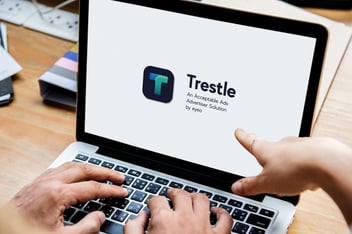
This post has been updated in February 2025 to reflect the most recent data available. This updated blog post explores the current state of ad filtering and provides key insights about ad-filtering users, incorporating the latest data from the 2024 eyeo and The Harris Poll research.
Ad blocking doesn’t mean what it used to.
Instead, most of today’s ad blockers integrate some form of ad filtering. Due to this fundamental change, the practice of ad blocking has shifted to reflect user preferences and industry practices. Most ad blockers are no longer all-out-blocking tools, and the overwhelming majority of users are, perhaps surprisingly, a demographic that does not mind seeing ads.
Ad filtering is the practice of selectively allowing ads instead of blocking them all. The Acceptable Ads Standard is specifically designed as a middle-way solution that blocks intrusive forms of advertising but, once the user agrees, allows light and unobtrusive advertisements. Giving users a better online experience while enabling publishers to monetize their valuable content.
But who are ad-filtering users? What motivates them? What is their relationship to privacy, their value to advertisers, and how do they aid in maintaining the vibrancy of the ad ecosystem?
Key facts about ad-filtering users
1. Although a percentage of internet users still blocks ads…(GWI)
...there are currently over 400 million ad-filtering users around the world.
That means a group of users (that’s only slightly smaller than the current population of the United States) that see nonintrusive ads that adhere to the Acceptable Ads Standard during their browsing experience.
These users exist on both desktop and mobile platforms.
2. Ad-filtering users don’t hate all hate ads
Past research, conducted using the data available from GlobalWebIndex (GWI) and YouGov, shows that over 90 percent of ad-blocking users state that they don’t hate ads. Not only that, but more than 83 percent are happy to see noninvasive, relevant ads. We see this research in action when looking at the number of users on Adblock Plus, AdBlock and other extensions and browsers that allow for an ad-filtering experience.
Not only that, but ad-filtering users prefer ad filtering to other methods of ad curation. According to the 2022 PageFair Adblock Report, 82 percent of adblock users prefer a lighter ad experience by default over receiving prompts to disable their ad blocker or whitelist a site.
A separate study conducted in 2023, featured in the 2023 eyeo Ad-Filtering Report, shows that 58 percent of ad-filtering users are open or neutral to seeing nonintrusive ads and only 20 percent express a strong dislike for ads.
3. Ad-filtering users don’t block all ads
They filter out intrusive or annoying ads.
What does this mean? By filtering ads, instead of blocking all ads, they are open to seeing some ads that do not disrupt their browsing experience.

While 81 percent of users download ad blockers to avoid disruptive/annoying ads (Blockthrough survey), research shows that users don’t mind seeing ads…as long as they don’t interfere with their browsing experience.
In a 2024 research conducted by eyeo and The Harris Poll, 89 percent of general users surveyed wish there were limits to the number of ads shown and/or their disruptiveness when visiting a website or streaming content for free. Another 89 percent desire ways to filter the types of ads shown when visiting a website or streaming content for free. (Please note that these users are general online users, not specifically ad-filtering users. However, their sentiment reflects the broader user perspective today.)
Read more about our latest whitepaper on consumer attitudes toward advertising
(Of course, there are other pressing reasons to steer clear of intrusive forms of advertising. According to GlobalWebIndex (GWI), both US and UK users find that distracting and disruptive ads can jeopardize a brand's online image. So if you’re an advertiser or a publisher reading this, take note!)
4. Privacy comes first
In 2021, we discovered that internet privacy is at the forefront of ad-filtering users’ minds. Digital privacy is a top motivating factor for ad-blocking use. Research from Statista and GWI shows that 44 percent of users have downloaded ad blockers to avoid being tracked online (Statista) and 59.3 percent need to know how their data will be protected before they feel comfortable sharing it (GWI and eyeo study 2021).
But the need for privacy doesn’t preclude ads. 74 percent of users don't mind advertising, as long as it respects their privacy and meets certain standards of quality (The 2021 PageFair Adblock Report).
Fast forward to 2024, a survey reveals that privacy is paramount for ad-filtering users, and almost all participants (96 percent) are taking some action to protect it. The 2024 eyeo and The Harris Poll whitepaper on consumer and industry perspectives showed that digital privacy concerns have risen to the forefront, causing consumers to become resistant to allowing more targeted advertising. 68 percent of mobile phone browser users and 64 percent of laptop/desktop users find the lack of privacy frustrating when using their respective devices.
Read more: Online privacy is important for online (and ad filtering) users
5. Tech-savvy, educated and digital-first: the ad-filtering demographic
Over the decade-long existence of Acceptable Ads, we’ve gotten to know a lot about ad-filtering users. And what we’ve learned is impressive.
Ad filterers are a savvy bunch: 15-19 percent are more confident in using new technology than the general population of internet users. They’re also 20 percent more likely to have higher education than non-ad-filtering users.
In 2023, eyeo conducted a study alongside MAGNA IPG on ‘Reaching and Influencing Ad-Filtering Users,’ which revealed that there are 58 percent more ad-filtering users from Gen Z than non-ad-blocking or non-ad-filtering users.
To provide a deeper understanding of ad-filtering users, let's explore some key personas that represent typical users in this demographic:
Ad-Filtering User Personas
|
Focused Josh: The Productivity-Driven Entrepreneur
|
|
*These personas are based on a small sample of pure qualitative data.
A GWI survey of 1,000 ad-blocking users reveals country-specific motivations:
In Germany, Focused Josh represents 41percent of the ad-blocking users. That means distractions-related problems (consent notifications/walls & pop-ups) are the most common in Germany.
While in the USA, Privacy-Conscious Matt represents 38 percent of the ad-blocking users which means that privacy-related problems are the most common in the USA.
These personas illustrate the diverse motivations and behaviors of ad-filtering users. While they share a common desire for a better online experience, their specific needs and concerns vary. This diversity underscores the importance of flexible, user-centric ad-filtering solutions that can cater to different preferences while maintaining a balance between user experience and publisher sustainability.
Understanding these personas can help advertisers, publishers and ad-tech companies develop more effective strategies to engage with ad-filtering users while respecting their preferences and concerns.
6. Purchase decision-making: an ad-filtering attribute
The MAGNA study shows that not only are ad-filtering users typically younger, they also make critical purchase decisions. In fact, they’re roughly 16 percent more likely to be the purchase decision-makers in the financial, tech and auto fields compared to non-ad-filtering users.
Supporting data from GWI shows that 43 percent of ad-filtering users tend to buy from brands they’ve seen advertisements for, and 58 percent of ad-filtering users display brand loyalty. Ad-filtering users also spend more time and money online and they often visit retail websites to discover brands, making them additionally valuable for retailers, publishers, and advertisers.
7. Ad-filtering users support publishers and understand the importance of ads to sustain a thriving online ecosystem
Research shows that 71 percent of US online users understand that publishers rely on advertising to keep their content free and 63 percent of ad-blocking users are willing to accept light, nonintrusive advertising to support publishers.
A 2022 eyeo | Samsung Internet study on Samsung Internet (SI) users supports that claim: most users, upon understanding the myriad benefits of ad filtering, are much more open to advertising.
While poor ad experiences are commonplace, often making digital content barely navigable, consumers generally appreciate the role of advertising in today's online ecosystem. Recent research from the Interactive Advertising Bureau (IAB) indicates that most people understand the value exchange between brands and access to free web content and services. In fact, nearly eight in 10 respondents prefer receiving more ads in exchange for free services rather than paying for subscriptions.
This aligns with The Harris Poll findings suggesting that consumers are eager to participate in potential solutions. Most web users don't inherently dislike or reject advertising; instead, they desire greater control and a more transparent value exchange, highlighting the need for a balanced approach to online advertising
8. A majority of publishers are monetizing ad-filtering users with Acceptable Ads
Of the top 100 US publishers to use adblock-monetization strategies, Acceptable Ads is the most popular.
In fact, all but two of the adblock-monetizing US 100 Comscore publishers use Acceptable Ads. This represents a huge leap: as of 2021, only 52 percent of these publishers used ad recovery via Acceptable Ads.
9. Banner blindness? Nope. Ad-filtering users are actually ‘ad aware’
Users who see scores of glittery, invasive ads tend to turn a little numb: rather than engage with advertisements, they become what’s known as “banner blind.
However, something very different happens with users who engage with nonintrusive ads like those deemed “acceptable” under the standard set forth by the independent Acceptable Ads Committee. Not only do these users not succumb to banner blindness, but they become ‘ad aware.’ This means that, when shown consented ad formats, these users are more likely to be receptive to and engage with the ad and the accompanying brand messaging.
The MAGNA study Reaching and Influencing Ad-Filtering Users also found that an ad-filtering experience (browsing in a low-clutter, respectful environment) results in an +82 percent aided ad recall – showing that ads are more memorable on low-cluttered pages.
10. Ad-filtering users are valuable for advertisers
Ad-filtering users are highly desirable, but it might seem as though they’re difficult to reach. The truth? They’re hiding in plain sight.
Advertisers can reap the benefits of reaching ad-filtering users, serving them fewer but more impactful ads, while simultaneously giving users control over their ad experience.
Reaching and Influencing Ad-Filtering Users outlined how a low-clutter ad environment isn’t just more cost-effective, it’s also a potent driver of establishing brand trust and leads to a more memorable experience for ad-filtering users.
Final thoughts
Ad-filtering users aren’t simply ad-blocking users with a new name. They’re so much more…and so much more valuable. By addressing their concerns and implementing user-friendly ad practices, the digital advertising industry can create a more mutually beneficial ecosystem for users, publishers, and advertisers alike.
Ours is a thriving and vibrant ecosystem, and ad filterers play an important role in keeping the ad ecosystem sustainable for all stakeholders. By accepting nonintrusive ads, ad-filtering users get to enjoy an immersive browsing experience—while enabling publishers and advertisers to generate valuable revenue.
To learn more about the ad standard that ad-filtering users agree with, visit https://acceptableads.com/standard.







